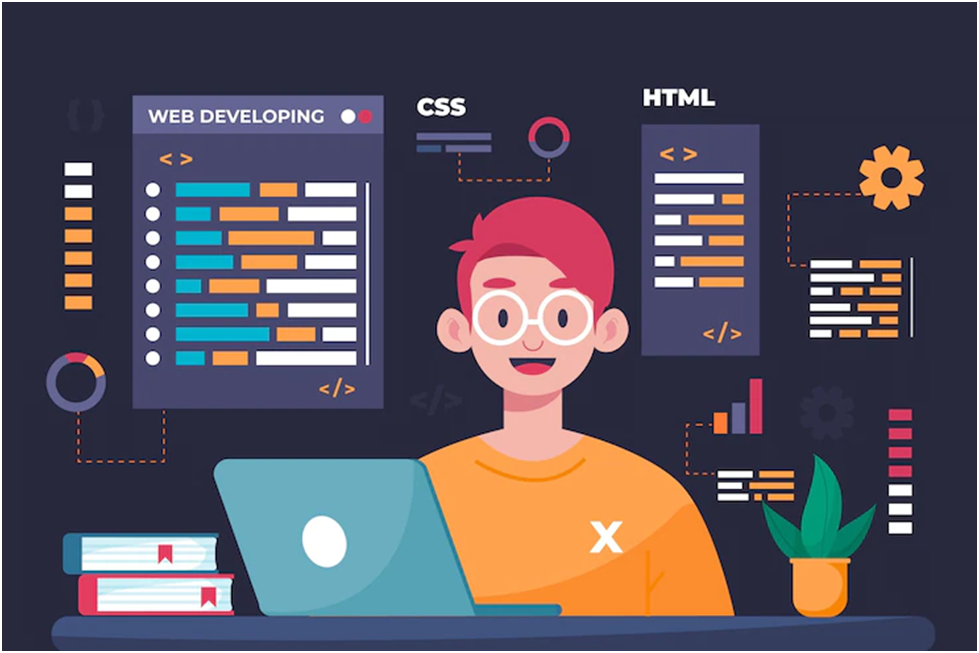Introduction:
Full stack developers are arguably among the most well-known experts in the web development industry. They are web developers who can work with a digital entity’s front and back sides. They are frequently knowledgeable about computer programming, user interface (UI) design, project management, and client interaction. The need for full-stack web developers has typically expanded due to this specialized hybridization in several different professional contexts.

What is Full stack development?
Three layers make up web design. The user interface side handles the presentational aspect of a page, program, or service, often known as the front end. The database manages the information interchange while the business logic layer, often known as the back end, handles information validation. A full-stack developer is in great demand as businesses and organizations strive toward continuous innovation. There was a significant divide between front-end web development and back-end engineers. Organizations on the bleeding edge of technology will likely notice you if you can create an application from start to finish.
Learn Full stack development:
You can learn the crucial abilities you need by enrolling in Full stack web development course introducing you to server-side and client-side development fundamentals. If you already have experience with one mobile development aspect, classes that teach you the other part will help you strengthen your skills and build your resume. Make sure you have everything you need to become a full-stack developer because many businesses are searching for a developer who can handle the entire production lifecycle.
Full stack development course and certification:
The full stack developer course syllabus includes the fundamentals of front-end development or back-end development for application development. In partnership with businesses at the forefront of innovation, we provide multiple methods focused on these responsibilities. You can learn front-end frameworks like Javascript, CSS, and HTML or server-side technologies like ASP.NET. We offer step-by-step full stack development training that teaches you how to operate complete Agile applications. You’ll learn about operating systems, well-known programming languages, and creating database functions in both back-end and front-end development. Even in the real world, you’ll need object-oriented programming to resolve issues.
Launch Your Career as a Full Stack Developer:
Continuous innovation has been achieved in web development. You have an advantage over groups of developers that know one side of a project if you understand it from beginning to end. Gaining access to a full stack engineering position is a must as businesses transition to Agile. A comprehensive skill set in software development equips you to address organizational needs and provide innovative mobile solutions to the user experience and business needs, whether you build mobile applications or online applications. Build your GitHub profile, get the required software training from the industry experts, and land that important position in full-stack web development.
The Important Skills and Languages for Full-Stack Developers:
The full stack developer role depends on a wide range of soft skills requiring at least some proficiency in various key programming languages. Our team offers the best javascript course for freshers. That being said, aspiring full-stack developers should learn the following demand skills and languages:

Freepik
Python:
Python is a valuable programming language for those interested in full stack development because it is one of the leading programming languages for back-end web development. The language is popular not only for its versatility but also for its ease of use. Indeed, according to Stack Overflow’s 2020 Developer Survey, Due to its compatibility with a variety of programming languages and its effectiveness in data visualization, Python was by far the most sought-after programming language.
Javascript:
JavaScript is another valuable coding skill in full stack development, ranking second only to Python among Stack Overflow’s surveyed developers. JavaScript, like Python, is known for its dynamic array of uses in back-end web development, which typically refer to the scope and excellence of a web page. It allows developers to make complex style declarations, backend server-side support high-level math calculations, and reference content from other web pages. Without JavaScript, websites would be more static, less animated, and ultimately less interesting.
HTML:
HTML – HyperText Markup Language is a common coding language in web development. It is a markup language and describes how web pages are connected. It is mostly used to teach a web browser via tags how to display the contents of a web page. For example, the label represents the header of a digital document, which may contain other markers related to information such as a title or relevant link.
CSS:
CSS – Cascading Style Sheets, along with JavaScript and HTML, is one of the most commonly used coding languages in front-end development, making it an asset to the full stack role. CSS, specifically the color and style-based code added to HTML structural elements, is primarily used to create an aesthetically pleasing design. For example, a background color: a light blue part would change the site’s user-facing background to light blue.
SQL:
SQL – Structured Query Language is a database language used in back-end development. The language is primarily used to manage and update records and access and modify databases. Because almost every website uses back-end data storage, SQL provides a solid foundation in database-oriented literacy required in full stack development – particularly for software developers designed to house sensitive data.
Rust:
Rust is also a popular programming language for web development, ranking as the “most loved” language in Stack Overflow’s 2020 survey. Rust is commonly used to improve the speed, parallelism, and inherent memory safety of a web page, and it is also valued for its versatility. These include the creation of game engines, the development of operating systems, and the implementation of browser components.
Java:
Java consistently ranks highly in top programming language rankings and surveys. This general-purpose language is primarily used in back-end web development but can be applied to various software types. Full stack developers must learn languages like Java because they can be applied to various scenarios in application development, maintenance, and conceptualization.
Web architecture:
Website architecture entails the planning and responsive design of a website’s technical mentor, functional, and visual components (before it is deployed). Web designers and developers use it to design and develop websites. As a result, full stack development and web architecture go hand in hand to build a strong, cohesive product efficiently. Full stack developers must understand how back-end data is structured and how to separate files and perform specific computational tasks.
Critical Thinking:
Web development is almost synonymous with high-level problem solving, which implies that developers are typically expected to be skilled critical thinkers. A mobile development project can frequently present various challenges, ranging from software limitations to back-end bugs. Developers should be prepared to navigate these issues with a comprehensive, solution-oriented mindset, improvising and attempting unconventional approaches as needed. Such thinking helps a project come to fruition and can drive the collective modern web development team’s growth, establishing a standard of tenacity and innovation for future real-world projects.
Patience:
Patience goes hand in hand with critical thinking in front-end web development. When troubleshooting and testing experimental ideas, developers should remain calm and proactive (both with themselves and with team cohorts). A solution to a complex problem is not always obvious. Patience can go a long way toward sustaining these efforts, which often require more time to establish themselves in the tech industry.
Communication:
Communication is another important soft skill that full-stack developers must have to do their job well. Achieving an innovation. This ability is crucial for new developers in particular. Developers may need to coordinate with clients, programmers, domain managers, and other internal departments. As they navigate their responsibilities on any given day, and because some people may not be as tech-savvy, clarity and transparency are essential. Front-end web development is frequently a collaborative effort, and cultivating this mindset can position new full-stack developers and their cohorts for long-term success.
Conclusion:
Full stack development is a difficult but rewarding role that combines critical front and back-end responsibilities, making it applicable to many technology jobs, many of which pay well and have long-term employment prospects. Learning this vital craft may appear daunting to the uninitiated, but it is possible through various educational career paths. Aspiring developers, for example, can enroll in our courses, as such options are a great way to learn full-stack fundamentals in a flexible, personalized setting. Alternatively, these individuals could pursue a traditional college technical degree in a field such as computer science or graphic design or seek self-directed learning opportunities through online courses or similar excellent resources.
